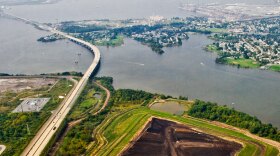The Environmental Protection Agency plans to clean up the Bear Creek Superfund site in Eastern Baltimore County over the next three years.
But residents who live nearby as well as environmentalists are concerned the cleanup project might not work and could do damage.
For decades, dangerous chemicals, including cancer-causing PCBs, were dumped into Bear Creek from Bethlehem Steel, which for a time was the largest steel producer in the world.
Mitch Cron, a project manager for the EPA, said PCBs remain in the sediment of Bear Creek. He said a goal of the cleanup is to keep PCBs away from fish and crabs.
“And by doing that, we want to protect birds, mammals and of course human beings as well, us,” Cron told residents at a public hearing in Dundalk Tuesday. “That’s the total food chain. We’re seeking to prevent PCBs from making its way through the food chain.”
Turner Station, an historically African American community, is on Bear Creek. Gloria Nelson, the President of the Turner Station Conservation Teams, said it’s time for the cleanup.
Nelson said, “Even though there are warning signs out there at Fleming Park and at Turner Park, there are warning signs trying to discourage fishing and crabbing. Folks are still doing it.”
The EPA is considering a $45 million cleanup of 60 acres of Bear Creek. Half of the creek’s floor in that area would be dredged and all of it would be capped with a two foot layer of sand. Cron said ideally the dredging would happen next year.
“And in 2026 the EPA would like to place the cap and begin monitoring to assure the cap stays in place,” Cron said.
Doug Myers, Maryland Senior Scientist at the Chesapeake Bay Foundation, said the EPA hasn’t convinced him the cap won’t just sink into soft sediment.
“They need to do a lot more geotechnical work with those sediments,” Myers said. “They need to tell us how deep the cores were that they collected the samples and can demonstrate to us that a sand cap of two feet in thickness is going to hold the sediments in place.”
Turner Station floods easily. So residents like Olivia Lomax want to know if water from the creek contaminated by the dredging will end up in their neighborhood.
“Turner Station’s very vulnerable to the flooding,” Lomax said. “And with global warming we’re going to be even more vulnerable.”
“It does flood,” Myers said. “It probably will flood at one point or another during the dredging operation. The potential for contaminants to get into Turner Station while that’s happening is real and needs to be addressed.”
Cron with the EPA said the project should not exacerbate the flooding at Turner Station and that the water used in the dredging will be tested before being dumped back into Bear Creek.
“We want this to work the first time,” Cron said. “One of the main approaches the EPA will take on this project is to verify the community is protected during the remediation itself.”
After decades of neglect and broken promises in Turner Station, Lomax said residents are suspicious. But she believes the EPA is trying to gain the community’s trust.
“They came and they listened,” Lomax said. “They were very considerate. They didn’t have all of the answers but in my heart of hearts I do believe that they want to do the right thing for the community.”
Gussie Maguire, Maryland Staff Scientist for the Chesapeake Bay Foundation, said she was concerned whether the EPA was considering climate change as it prepared for the Bear Creek cleanup but the EPA’s assurances that they are put her at ease.
“We do have ever increasing rainfall records in the area,” Maguire said. “Making sure that whatever engineering they put into this they are accounting for not just necessarily a 100 year storm, but a 500 year storm. They did say they were looking at that and that was part of the standard EPA Process. So I was definitely relieved to hear that.”
Meantime, there is a second, separate dredging operation being planned for Sparrows Point. This one is for a container terminal for Tradepoint Atlantic, the massive shipping center that has replaced Bethlehem Steel.
Turner Station residents worry that two simultaneous dredging operations could do environmental damage.
“When you say ‘dredging,’ that’s fearful right there,” Nelson said. “That sends out an alarm. People are going to question. People are going to be fearful because it’s the unknown.”
Pete Haid, a vice president at Tradepoint Atlantic, said their dredging operation should happen after the EPA’s is finished.
“It’s likely that the remediation that EPA is proposing will be in progress or done prior to us getting permits to build the terminal,” Haid said.
The EPA considered a more expensive $70 million cleanup at Bear Creek, in which all 60 acres would be dredged, then capped. It concluded it would not be much more protective than the $45 million option it favors.
Doug Myers at the Chesapeake Bay Foundation isn’t so sure. Myers said there are other toxic pollutants besides PCBs in Bear Creek.
“We know they’re out there and the larger area we know is contaminated,” Myers said. “So we’re not going to probably jump directly on the bandwagon of EPA’s preferred alternative. We may want to see more of that $70 million range project that they scoped.”
The EPA is taking public comment on the Bear Creek Cleanup until March 10.





